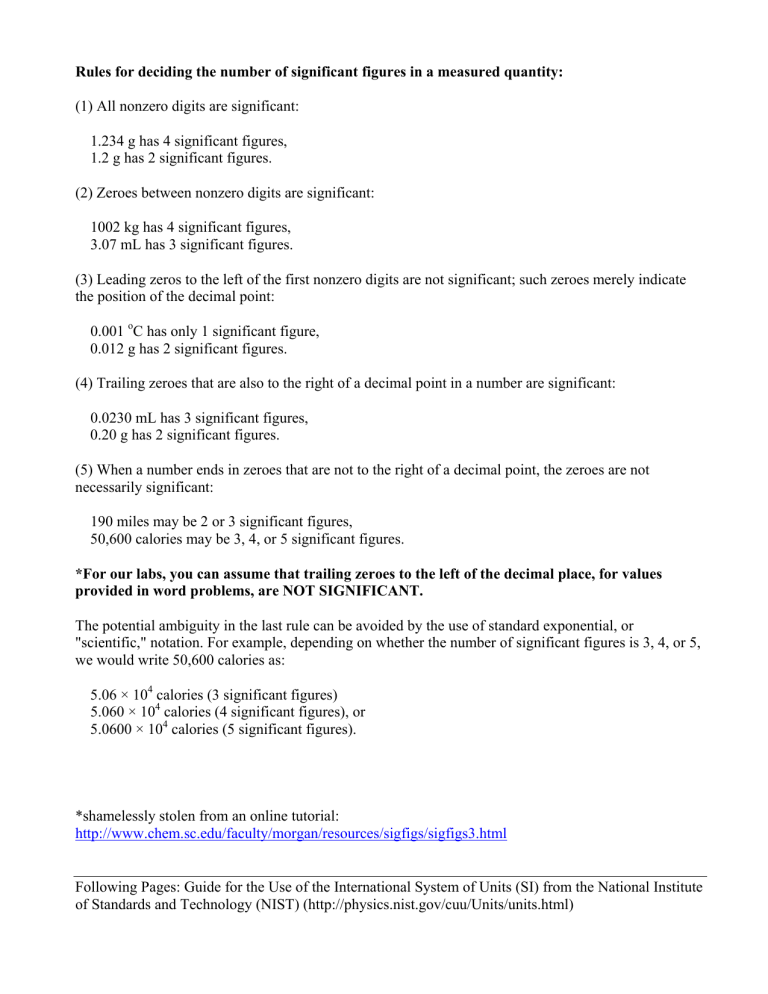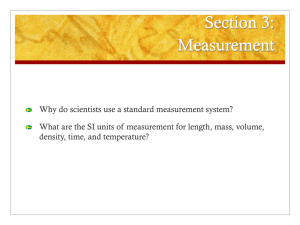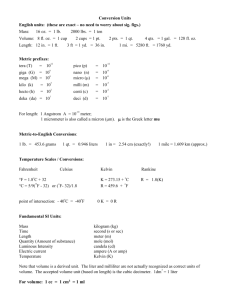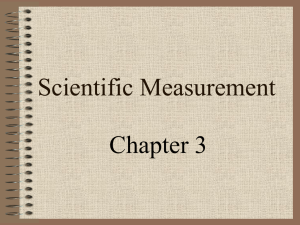Significant Figures and SI Units
advertisement

Rules for deciding the number of significant figures in a measured quantity: (1) All nonzero digits are significant: 1.234 g has 4 significant figures, 1.2 g has 2 significant figures. (2) Zeroes between nonzero digits are significant: 1002 kg has 4 significant figures, 3.07 mL has 3 significant figures. (3) Leading zeros to the left of the first nonzero digits are not significant; such zeroes merely indicate the position of the decimal point: 0.001 oC has only 1 significant figure, 0.012 g has 2 significant figures. (4) Trailing zeroes that are also to the right of a decimal point in a number are significant: 0.0230 mL has 3 significant figures, 0.20 g has 2 significant figures. (5) When a number ends in zeroes that are not to the right of a decimal point, the zeroes are not necessarily significant: 190 miles may be 2 or 3 significant figures, 50,600 calories may be 3, 4, or 5 significant figures. *For our labs, you can assume that trailing zeroes to the left of the decimal place, for values provided in word problems, are NOT SIGNIFICANT. The potential ambiguity in the last rule can be avoided by the use of standard exponential, or "scientific," notation. For example, depending on whether the number of significant figures is 3, 4, or 5, we would write 50,600 calories as: 5.06 × 104 calories (3 significant figures) 5.060 × 104 calories (4 significant figures), or 5.0600 × 104 calories (5 significant figures). *shamelessly stolen from an online tutorial: http://www.chem.sc.edu/faculty/morgan/resources/sigfigs/sigfigs3.html Following Pages: Guide for the Use of the International System of Units (SI) from the National Institute of Standards and Technology (NIST) (http://physics.nist.gov/cuu/Units/units.html) Guide for the Use of the International System of Units (SI) 4.1 SI base units Table 1 gives the seven base quantities, assumed to be mutually independent, on which the SI is founded, and the names and symbols of their respective units, called “SI base units.” Definitions of the SI base units are given in Appendix A. The kelvin and its symbol K are also used to express the value of a temperature interval or a temperature difference (see Sec. 8.5). Table 1. SI base units SI base unit Base quantity length mass time electric current thermodynamic temperature amount of substance luminous intensity 4.2 Name meter kilogram second ampere kelvin mole candela Symbol m kg s A K mol cd SI derived units Derived units are expressed algebraically in terms of base units or other derived units. The symbols for derived units are obtained by means of the mathematical operations of multiplication and division. For example, the derived unit for the derived quantity molar mass (mass divided by amount of substance) is the kilogram per mole, symbol kg/mol. Additional examples of derived units expressed in terms of SI base units are given in Table 2. (The rules and style conventions for printing and using SI unit symbols are given in Secs. 6.1.1 to 6.1.8.) Table 2. Examples of SI coherent derived units expressed in terms of SI base units SI coherent derived unit Derived quantity Name Symbol area square meter m2 volume cubic meter m3 speed, velocity meter per second m/s acceleration meter per second squared m/s2 wavenumber reciprocal meter m−1 density, mass density kilogram per cubic meter kg/m3 specific volume cubic meter per kilogram m3/kg current density ampere per square meter A/m2 magnetic field strength ampere per meter A/m luminance candela per square meter cd/m2 amount-of-substance concentration amount concentration , concentration mole per cubic meter mol/m3 4.2.1 SI coherent derived units with special names and symbols Certain SI coherent derived units have special names and symbols; these are given in Table 3. Consistent with the discussion in Sec. 4, the radian and steradian, which are the two former supplementary units, are included in Table 3. The last four units in Table 3 were introduced into the SI for reasons of safeguarding human health. 4 Guide for the Use of the International System of Units (SI) Table 3. The 22 SI coherent derived units with special names and symbols. SI coherent derived unit (a) Special name Special Expression in symbol terms of other SI units plane angle radian (b) rad 1 (b) (b) (c) solid angle steradian sr 1 (b) (d) Hz frequency hertz force newton N pressure, stress pascal Pa N/m2 energy, work, joule J N·m amount of heat power, radiant flux watt W J/s electric charge, coulomb C amount of electricity electric potential difference(e), volt V W/A electromotive force capacitance farad F C/V electric resistance ohm Ω V/A electric conductance siemens S A/V magnetic flux weber Wb V·s magnetic flux density tesla T Wb/m2 inductance henry H Wb/A Celsius temperature degree Celsius (f) ºC luminous flux lumen lm cd · sr(c) illuminance lux lx lm/m2 (d) becquerel Bq activity referred to a radionuclide (g) absorbed dose, gray Gy J/kg specific energy (imparted), kerma dose equivalent, Sv J/kg sievert (h) ambient dose equivalent, directional dose equivalent, personal dose equivalent catalytic activity katal kat (a) (b) (c) (d) (e) (f) (g) (h) Expression in terms of SI base units m/m m2/m2 s−1 m · kg · s−2 m−1 · kg · s−2 m2 · kg · s−2 m2 · kg · s−3 s·A m2 · kg · s−3 · A–1 m−2 · kg−1 · s4 · A2 m2 · kg · s−3 · A−2 m−2 · kg−1 · s3 · A2 m2 · kg · s−2 · A−1 kg · s−2 · A−1 m2 · kg · s−2 · A−2 K Cd m−2 · cd s−1 m2 · s−2 m2 · s−2 s−1 · mol The SI prefixes may be used with any of the special names and symbols, but when this is done the resulting unit will no longer be coherent. (See Sec. 6.2.8.) The radian and steradian are special names for the number one that may be used to convey information about the quantity concerned. In practice the symbols rad and sr are used where appropriate, but the symbol for the derived unit one is generally omitted in specifying the values of dimensionless quantities. (See Sec 7.10.) In photometry the name steradian and the symbol sr are usually retained in expressions for units. The hertz is used only for periodic phenomena, and the becquerel is used only for stochastic processes in activity referred to a radionuclide. Electric potential difference is also called “voltage” in the United States. The degree Celsius is the special name for the kelvin used to express Celsius temperatures. The degree Celsius and the kelvin are equal in size, so that the numerical value of a temperature difference or temperature interval is the same when expressed in either degrees Celsius or in kelvins. (See Secs. 4.2.1.1 and 8.5.) Activity referred to a radionuclide is sometimes incorrectly called radioactivity. See Refs. [1, 2], on the use of the sievert. 4.2.1.1 Degree Celsius In addition to the quantity thermodynamic temperature (symbol T), expressed in the unit kelvin, use is also made of the quantity Celsius temperature (symbol t) defined by the equation t = T − T0, 5 Guide for the Use of the International System of Units (SI) where T0 = 273.15 K by definition. To express Celsius temperature, the unit degree Celsius, symbol ºC, which is equal in magnitude to the unit kelvin, is used; in this case, “degree Celsius” is a special name used in place of “kelvin.” An interval or difference of Celsius temperature, however, can be expressed in the unit kelvin as well as in the unit degree Celsius (see Sec. 8.5). (Note that the thermodynamic temperature T0 is exactly 0.01 K below the thermodynamic temperature of the triple point of water (see Sec. A.6).) 4.2.2 Use of SI derived units with special names and symbols Examples of SI derived units that can be expressed with the aid of SI derived units having special names and symbols are given in Table 4. Table 4. Examples of SI coherent derived units expressed with the aid of SI derived units having special names and symbols. SI coherent derived unit Derived quantity Name Symbol Expression in terms of SI base units dynamic viscosity pascal second Pa · s m−1 · kg · s−1 moment of force newton meter N·m m2 · kg · s−2 surface tension newton per meter N/m kg · s–2 rad/s m · m−1 · s−1 = s−1 angular velocity radian per second 2 m · m−1 · s−2 = s−2 angular acceleration radian per second squared rad/s 2 kg · s−3 heat flux density, watt per square meter W/m irradiance heat capacity, entropy joule per kelvin J/K m2 · kg · s−2 · K−1 specific heat capacity, joule per kilogram kelvin J/(kg · K) m2 · s−2 · K−1 specific entropy specific energy joule per kilogram J/kg m2 · s−2 thermal conductivity watt per meter kelvin W(m · K) m · kg · s−3 · K−1 3 m−1 · kg · s−2 energy density joule per cubic meter J/m electric field strength volt per meter V/m m · kg · s−3 · A−1 3 m−3 · s · A electric charge density coulomb per cubic meter C/m 2 m−2 · s · A surface charge density coulomb per square meter C/m 2 m−2 · s · A electric flux density, coulomb per square meter C/m electric displacement permittivity farad per meter F/m m−3 · kg−1 · s4 · A2 permeability henry per meter H/m m · kg · s−2 · A−2 molar energy joule per mole J/mol m2 · kg · s−2 · mol−1 molar entropy, joule per mole kelvin J/(mol · K) m2 · kg · s−2 · K−1 · mol−1 molar heat capacity exposure (x and γ rays) coulomb per kilogram C/kg kg−1 · s · A absorbed dose rate gray per second Gy/s m2 · s−3 radiant intensity watt per steradian W/sr m4 · m−2 · kg · s−3 = m2 · kg · s−3 2 m2 · m−2 · kg · s−3 = kg · s−3 radiance watt per square meter W/(m · sr) steradian catalytic activity katal per cubic meter kat/m3 m−3 · s−1 · mol concentration The advantages of using the special names and symbols of SI derived units are apparent in Table 4. Consider, for example, the quantity molar entropy: the unit J/(mol · K) is obviously more easily understood than its SI base-unit equivalent, m2 · kg · s−2 · K−1 · mol−1. Nevertheless, it should always be recognized that the special names and symbols exist for convenience; either the form in which special names or symbols are used for certain combinations of units or the form in which they are not used is correct. For example, because of the descriptive value implicit in the compound-unit form, communication is sometimes facilitated if magnetic flux (see Table 3) is expressed in terms of the volt second (V · s) instead of the weber (Wb) or the combination of SI base units, m2 · kg · s−2 · A−1. 6




